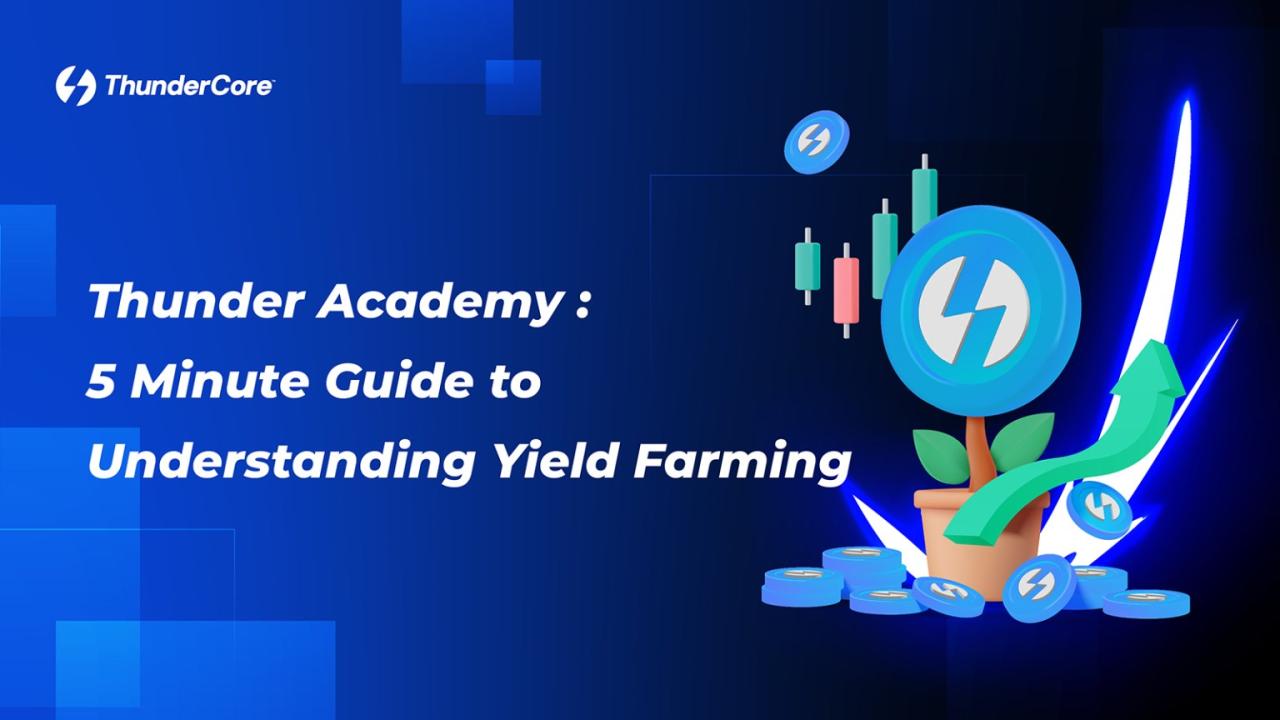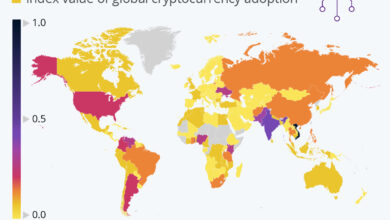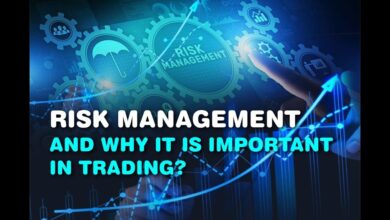
Yield Farming for Passive Income Strategies Explained
Understanding Yield Farming Strategies to Generate Consistent Passive Income is crucial for navigating the ever-evolving world of cryptocurrency. This guide delves into the intricacies of yield farming, offering a comprehensive overview of strategies, risks, and potential rewards.
From basic principles to advanced techniques, we’ll explore the different types of yield farming strategies, including staking and liquidity provision. We’ll also examine the critical role of selecting appropriate crypto assets and understanding the various DeFi platforms available.
Introduction to Yield Farming
Yield farming is a relatively new strategy in the cryptocurrency space that allows users to earn returns on their crypto holdings. It leverages decentralized finance (DeFi) protocols to generate passive income, often in the form of crypto tokens. This differs from traditional investments by employing smart contracts and decentralized platforms, which removes intermediaries and typically involves a degree of risk.The core principle behind yield farming is to strategically deploy crypto assets into various DeFi protocols.
These protocols offer different yield farming strategies, each with its own set of risks and rewards. By understanding these strategies, individuals can potentially generate passive income, though it’s important to remember that no investment guarantees returns.
Yield Farming Strategies
Understanding the various yield farming strategies is crucial for navigating the opportunities and challenges within this space. Different strategies cater to various risk tolerances and investment goals.
| Strategy Type | Description | Example |
|---|---|---|
| Staking | Staking involves locking up crypto assets in a specific platform or protocol. In return, users receive rewards in the form of crypto tokens or other incentives. The reward is often dependent on the duration of the staking period. | Staking ETH on a platform like Lido Finance to earn stETH, which can then be used for further yield farming or swapped for ETH. |
| Liquidity Provision | Liquidity provision involves supplying trading pairs of crypto assets to decentralized exchanges (DEXs). By providing liquidity, users enable seamless trading and earn rewards in the form of fees or platform tokens. | Providing liquidity to a DEX pair like Uniswap with ETH/USDT to earn trading fees and potentially UNI tokens. |
| Borrowing and Lending | Borrowing and lending platforms allow users to lend their crypto assets to others in exchange for interest or fees. Conversely, users can borrow crypto assets, using them as collateral, at an agreed-upon interest rate. | Lending ETH on Aave to earn interest in ETH or other tokens. |
| Yield Aggregators | Yield aggregators are platforms that automate the process of finding and optimizing yield farming opportunities. They pool different yield farms, making the process more accessible to less experienced users. | Using a yield aggregator like Yearn Finance to access and manage various yield farming opportunities in one place. |
Passive Income Generation in Yield Farming
The concept of passive income in yield farming revolves around generating returns without significant active management. While the initial setup and research may require some effort, successful yield farming strategies can generate income over time. However, it is critical to understand that passive income is not guaranteed. The risk of loss exists, and understanding the volatility of crypto markets is essential.
There’s no foolproof method. Returns vary based on market conditions, platform performance, and the chosen strategy. Diligent research and risk assessment are vital.
Understanding Crypto Assets and Protocols: Understanding Yield Farming Strategies To Generate Consistent Passive Income

Source: getmidnight.com
Yield farming hinges on the right choices in crypto assets and the underlying protocols. Picking the wrong combination can lead to substantial losses. This section delves into the crucial factors to consider when navigating the world of yield farming. Understanding the characteristics of various crypto assets and the protocols that govern their interactions is essential for success.Careful selection of crypto assets is critical to yield farming’s success.
The value of your returns depends directly on the asset’s performance within the chosen protocols. Understanding the market dynamics, tokenomics, and overall project viability is paramount to mitigating risk and maximizing potential returns.
Selecting Appropriate Crypto Assets
Choosing the right crypto assets for yield farming requires careful consideration. The asset’s price volatility, market capitalization, and the overall health of the ecosystem are key indicators. Assets with a history of stable or growing demand often offer better opportunities for consistent yield farming returns. Projects with a strong community and active development tend to have more resilience.
Furthermore, the utility of the asset within the chosen protocol influences its yield farming potential.
Different Crypto Protocols and Their Functionalities
Various protocols facilitate yield farming. Each protocol offers unique functionalities, and these variations affect how assets are utilized and the associated returns. Some protocols focus on lending and borrowing, others on staking or liquidity provision. Understanding these differences is critical for aligning your strategy with a suitable protocol. The protocols’ security, transparency, and the overall project roadmap play a crucial role in assessing their long-term viability.
Comparison of DeFi Platforms
Decentralized finance (DeFi) platforms are the primary hubs for yield farming activities. They offer diverse features, each with its own advantages and disadvantages. For example, some platforms might have higher APRs but potentially higher risks, while others prioritize security and stability. User interface (UI) and user experience (UX) also play a significant role in the ease of navigation and participation.
Liquidity pools, borrowing and lending, and staking options are essential features to consider when choosing a DeFi platform.
Table of Crypto Assets, Protocols, and Risk Profiles
The table below Artikels different crypto assets, their associated protocols, and their corresponding risk profiles. This framework helps in assessing the potential risks and rewards of each investment. Risk assessment is essential for managing potential losses.
| Crypto Asset | Associated Protocol | Risk Profile |
|---|---|---|
| Bitcoin (BTC) | Various Lending/Staking Protocols | Lower (due to established market presence and widespread adoption) |
| Ethereum (ETH) | Various Lending/Staking/Liquidity Protocols | Medium (high price volatility, but significant utility in DeFi) |
| Stablecoins (e.g., USDC, USDT) | Lending/Staking Protocols | Low (designed to maintain a stable price) |
| DeFi Tokens (e.g., AAVE, COMP) | Specific DeFi Platforms | High (highly dependent on the success of the protocol) |
Risk Assessment and Mitigation Strategies
Yield farming, while promising, carries inherent risks. Understanding these risks and implementing robust mitigation strategies is crucial for maximizing potential rewards and minimizing losses. A proactive approach to risk assessment allows for informed decisions and helps navigate the volatile landscape of decentralized finance.Yield farming strategies, despite their potential for high returns, are not without inherent risks. These risks can stem from various factors, including the volatility of crypto markets, the security of the protocols involved, and the inherent complexity of the strategies themselves.
Proactive risk assessment and mitigation strategies are essential for navigating these challenges and achieving sustainable success in this domain.
Key Risks Associated with Yield Farming
Yield farming strategies are susceptible to several key risks. Market volatility can drastically impact the value of the assets being farmed, leading to significant losses. Security vulnerabilities within the protocols used for yield farming can expose investors to hacks and exploits. Furthermore, the complexity of some yield farming strategies can lead to unforeseen issues and losses if not thoroughly understood.
Mitigation Strategies: Diversification and Due Diligence
Diversifying your yield farming portfolio across different protocols and assets is a crucial risk mitigation strategy. By spreading your investments, you reduce the impact of any single protocol or asset experiencing a downturn. Similarly, thorough due diligence is paramount. Carefully researching the security of the protocol, the reputation of the team behind it, and the overall market sentiment for the assets involved will help identify potential red flags.
Importance of Understanding Market Volatility
Market volatility is a significant risk factor in yield farming. Cryptocurrency markets are known for their unpredictable price swings. Yield farming returns are often tied to the performance of the underlying assets. Therefore, a thorough understanding of market volatility and its potential impact on yield farming returns is crucial. Investors should anticipate potential downturns and have strategies in place to mitigate their impact.
For example, the 2018 crypto winter saw significant losses for many yield farming investors who were unprepared for the drastic price declines. Understanding and anticipating market volatility is key to navigating this unpredictable landscape.
Potential Risks and Mitigation Strategies
- Protocol Vulnerability: Smart contracts underlying yield farming protocols can contain vulnerabilities. Thorough audits and security assessments of the protocols before participation are vital. Consider the reputation and experience of the auditing firms. Seek professional advice to evaluate the security and stability of the protocols you’re considering.
- Impermanent Loss: Yield farming often involves staking assets in a liquidity pool. Price fluctuations between the assets in the pool can lead to impermanent loss. Diversifying across pools with stable asset ratios can mitigate this risk. Understanding the mechanics of impermanent loss is critical before participating in liquidity pools.
- Market Manipulation: Market manipulation can artificially inflate or deflate the price of assets, affecting returns. Thorough market research and analysis of historical data can help identify potential signs of manipulation. Focus on projects with robust communities and strong fundamentals to minimize this risk.
- Rug Pulls: Scammers may create fake projects to attract investors, promising high returns and then disappearing with the funds. Thorough research into the team behind the project, their track record, and the project’s whitepaper is crucial. Look for transparency and a strong community.
- Regulatory Uncertainty: The regulatory landscape for cryptocurrencies is constantly evolving. Changes in regulations can impact yield farming strategies and market conditions. Staying informed about the latest developments in the regulatory environment is critical for long-term success.
Strategies for Maximizing Returns

Source: thundercore.com
Figuring out yield farming strategies to build passive income streams is fascinating, but sometimes you need a quick, natural pain reliever. Did you know that black nutmeg and cloves can be used for natural pain relief? Check out this helpful guide on How to Use Black Nutmeg and Clove for Natural Pain Relief for some natural remedies.
Ultimately, while exploring these natural methods, remember to still stay focused on understanding the intricacies of yield farming for a truly consistent passive income.
Yield farming, while offering the potential for significant returns, demands a strategic approach to achieve consistent passive income. Blindly jumping into any opportunity can lead to substantial losses. A methodical approach, focusing on understanding the underlying mechanics of yield farming protocols and identifying high-potential opportunities, is crucial for success. This section will explore effective strategies to maximize returns, emphasizing the importance of compounding and providing a framework for identifying profitable opportunities.Successful yield farming relies on a multifaceted strategy that combines careful selection of opportunities with an understanding of compounding returns.
Identifying profitable opportunities requires in-depth research, a keen eye for market trends, and a willingness to adapt to changing conditions.
Effective Strategies for Maximizing Returns
Effective strategies in yield farming encompass various aspects, from choosing the right protocols to optimizing compounding strategies. Understanding the interplay of these factors is essential for maximizing returns.
- Diversification Across Protocols: Diversifying investments across different decentralized finance (DeFi) protocols reduces risk. This approach allows for exposure to various yield farming opportunities, each with its unique risk profile and potential returns. A diversified portfolio can help mitigate losses in specific protocols experiencing downturns or vulnerabilities.
- Understanding Protocol Mechanics: Thorough research into the underlying mechanics of each protocol is crucial. This includes understanding the tokenomics, governance models, and the overall security and stability of the platform. Knowing the protocol’s history, active community, and security measures helps assess the risks and potential rewards.
- Optimizing Compounding Strategies: Compounding interest is a fundamental aspect of generating consistent income in yield farming. Strategies to maximize compounding involve automating the reinvestment of earned yield tokens to generate more yield over time. This process can be automated through various DeFi tools and smart contracts, making compounding an efficient way to grow returns exponentially.
Identifying Profitable Yield Farming Opportunities
Identifying profitable yield farming opportunities requires a systematic approach combining market analysis and protocol evaluation. A well-defined process helps in making informed decisions.
- Market Analysis: Monitoring market trends, including the performance of related cryptocurrencies and overall market sentiment, is essential. Tracking the price volatility and overall market health can inform investment decisions.
- Protocol Evaluation: Evaluating the specific protocols offers insights into the potential for return and risk. This includes considering factors like liquidity pools, APR, token price stability, and the overall reputation of the protocol.
Flowchart for Identifying and Evaluating Yield Farming Opportunities
This flowchart illustrates the process for identifying and evaluating yield farming opportunities.“`[Start] –> [Market Analysis] –> [Identify Potential Protocols] –> [Protocol Evaluation] | V [Risk Assessment] –> [Opportunity Selection] –> [Implementation] –> [Monitoring & Adjustment] –> [End]“`This flowchart provides a systematic approach to evaluating yield farming opportunities.
Each step plays a vital role in identifying high-potential opportunities and mitigating risks.
Practical Implementation and Management

Source: ytimg.com
Yield farming, while offering potentially lucrative returns, requires meticulous planning and execution. This stage involves navigating the complexities of choosing platforms, allocating assets strategically, and continuously monitoring performance to maximize gains and mitigate risks. Effective management is key to transforming potential profits into consistent passive income.
Setting Up a Yield Farming Strategy
Implementing a yield farming strategy involves a series of crucial steps. Careful selection of platforms and assets is paramount to maximizing returns while minimizing exposure to risk.
- Platform Selection: Thorough research and due diligence are critical when selecting a yield farming platform. Consider factors like platform security, liquidity, transaction fees, and user reviews. Reputable platforms with strong security measures and transparent protocols are essential for safeguarding investments.
- Asset Allocation: Allocating assets across different yield farming opportunities requires careful consideration of risk tolerance and potential returns. Diversification is key, spreading investments across various platforms and assets to mitigate risk. A well-balanced portfolio should consider the volatility of each asset and the platform’s overall stability.
- Understanding Smart Contracts: Yield farming often involves interacting with smart contracts. Understanding how these contracts function, including their parameters and limitations, is crucial for making informed decisions. Analyze the smart contract code, if available, to understand the protocol’s mechanics and potential vulnerabilities.
Monitoring and Managing Yield Farming Investments
Consistent monitoring and proactive management are vital for success in yield farming. This involves tracking performance, adjusting strategies, and responding to market changes.
Figuring out yield farming strategies to build consistent passive income can be tricky, but it’s definitely rewarding. While you’re researching different platforms and protocols, you might also want to check out some natural ways to improve your digestion, like exploring the amazing benefits of garlic and black pepper. Unlock the Secret Benefits of Garlic and Black Pepper for Digestion This knowledge can help you focus on your overall well-being, which is crucial when diving deep into the world of yield farming.
Ultimately, understanding the nuances of yield farming will help you make sound financial decisions.
- Performance Tracking: Regularly monitor the performance of your yield farming investments. This includes tracking returns, fees, and any changes in the value of the underlying assets. Using dedicated tracking tools or spreadsheets can simplify this process.
- Risk Assessment and Mitigation: Periodically reassess the risk associated with your yield farming investments. Market conditions can change rapidly, and adjusting strategies based on evolving risks is crucial. Consider the potential for losses due to platform failures, market crashes, or smart contract vulnerabilities.
- Adapting to Market Fluctuations: The cryptocurrency market is dynamic. Adjust your strategies based on changing market conditions. This might involve rebalancing your portfolio, shifting assets to more stable platforms, or withdrawing funds in times of high risk.
Step-by-Step Guide to Implementation
This step-by-step guide Artikels the process of implementing a yield farming strategy:
- Research and Due Diligence: Thoroughly research potential yield farming platforms and the underlying assets. Evaluate security, liquidity, and user reviews.
- Define Risk Tolerance: Establish your risk tolerance level to determine the appropriate asset allocation strategy. Diversify across different platforms and assets to mitigate risk.
- Asset Allocation: Allocate assets across chosen yield farming opportunities based on your risk tolerance and expected returns. Diversification is key.
- Monitoring and Analysis: Regularly monitor the performance of your investments. Track returns, fees, and asset values. Adjust strategies as needed to respond to market changes.
- Continuous Learning: Stay updated on market trends, platform developments, and emerging yield farming strategies. Adaptability is crucial in this dynamic environment.
Portfolio Management Strategies
Managing a yield farming portfolio requires a strategic approach that balances risk and reward. The table below illustrates various strategies, associated risks, and potential returns.
| Strategy | Risk | Potential Return |
|---|---|---|
| High-Yield, High-Risk | Significant potential for loss due to platform failures, market volatility, or smart contract exploits. | Potentially high returns but also substantial risk of capital loss. |
| Moderate-Yield, Moderate-Risk | Medium level of risk associated with platform instability, asset price fluctuations, and market conditions. | Balanced returns, with a moderate degree of risk. |
| Low-Yield, Low-Risk | Minimal risk associated with established platforms and stable assets. | Lower returns but also lower risk of significant capital loss. |
Long-Term Considerations and Future Trends
Yield farming, while offering potentially high returns, isn’t a get-rich-quick scheme. Understanding its long-term implications is crucial for sustainable success. The crypto landscape is dynamic, and strategies that work today might not be effective tomorrow. This section explores the evolving nature of yield farming, potential regulatory hurdles, and future projections.The yield farming landscape is constantly evolving, driven by technological advancements, market shifts, and regulatory developments.
Staying adaptable and informed is paramount to navigating this ever-changing environment.
Long-Term Implications of Yield Farming Strategies
Yield farming strategies, while offering attractive returns, come with inherent risks. Maintaining a diversified portfolio, coupled with thorough due diligence, is vital for mitigating these risks. The volatile nature of crypto markets demands a long-term perspective, not a short-term investment approach.
Evolving Landscape of Yield Farming and its Future Prospects
The yield farming ecosystem is experiencing significant changes. New protocols and strategies are constantly emerging. This dynamic environment demands continuous learning and adaptation. The emergence of decentralized finance (DeFi) protocols has broadened the scope of yield farming opportunities, but the lack of regulatory clarity poses a challenge to its long-term viability.
Potential Impact of Regulatory Changes on Yield Farming
Government regulations are increasingly scrutinizing the crypto space. Regulatory frameworks are evolving globally, and their implications for yield farming are substantial. Regulations regarding security tokens, stablecoins, and other crypto assets directly affect the viability of yield farming strategies. The potential for stricter regulations impacting the availability of certain protocols and services could dramatically change the yield farming landscape.
Predictions on the Future of Yield Farming
Predicting the future of yield farming is challenging, but certain trends are noteworthy.
- Increased Regulation and Compliance: Governments globally are likely to implement stricter regulations, potentially impacting certain yield farming strategies and protocols. Examples include the increasing scrutiny of stablecoins and the rise of regulatory frameworks in various jurisdictions.
- Focus on Decentralized Finance (DeFi) Innovation: Innovation in DeFi protocols will likely lead to more sophisticated yield farming opportunities. Improved security, transparency, and user experience will be critical for the success of these platforms.
- Emphasis on Sustainable and Environmentally Friendly Protocols: Sustainability and environmental concerns are increasingly important factors in the crypto ecosystem. Protocols that minimize their environmental impact will likely gain prominence.
- Rise of Automated Yield Farming Strategies: Automated platforms will streamline yield farming processes, making it more accessible to a wider range of investors.
- Growing Importance of Risk Management: Investors will likely prioritize sophisticated risk management tools and strategies to navigate the inherent volatility of yield farming.
Tools and Resources for Yield Farming
Staying ahead in the dynamic world of yield farming requires more than just understanding the strategies. It demands constant vigilance and access to reliable tools and resources to navigate the ever-evolving landscape. This involves identifying promising opportunities, evaluating risks, and adapting to emerging trends. This section dives deep into the crucial tools and resources that can empower you in your yield farming journey.Staying informed about the latest yield farming trends and tools is paramount.
Figuring out yield farming strategies to build consistent passive income can be tricky, but it’s definitely achievable! Think about how incorporating healthy habits like drinking ginger tea daily can positively impact your overall well-being, as detailed in this insightful article Why Drinking Ginger Tea Daily Can Transform Your Well-being. Focusing on both your physical and financial well-being can create a powerful synergy, ultimately helping you master those yield farming strategies and generate that passive income stream.
Ignoring market shifts and new technologies can lead to missed opportunities and significant losses. Reliable resources can provide insights into emerging protocols, innovative strategies, and potential risks.
Yield Farming Opportunity Analysis Tools
Comprehensive analysis tools are essential for identifying promising yield farming opportunities. These tools can help evaluate the potential returns, risks, and liquidity of different protocols and strategies. Thorough research, using these tools, can significantly increase the likelihood of success.
- Decentralized Finance (DeFi) Aggregators: These platforms aggregate yield farming opportunities across various protocols, providing a centralized view of available options. This consolidation allows for a broader comparison of potential yields and risks, streamlining the process of finding profitable opportunities.
- Yield Optimizer Platforms: Specialized tools that analyze your specific portfolio and suggest the optimal yield farming strategies to maximize returns. These tools can consider your risk tolerance, desired returns, and available capital to tailor strategies to your unique circumstances.
- Cryptocurrency Market Data Providers: Sites like CoinGecko and CoinMarketCap provide crucial data on token prices, market capitalization, and trading volumes. This data is critical for assessing the liquidity of the assets involved in yield farming opportunities, and understanding the overall market sentiment.
Staying Updated on Yield Farming Trends, Understanding Yield Farming Strategies to Generate Consistent Passive Income
Keeping up with the latest yield farming trends is vital for making informed decisions. The DeFi space is constantly evolving, with new protocols, strategies, and risks emerging regularly. Staying current with industry news, research, and social media discussions can provide a competitive edge.
- Following Crypto News Outlets: Reputable crypto news outlets and blogs offer in-depth analysis of yield farming strategies, market trends, and emerging protocols. These sources can provide timely insights into potential risks and opportunities.
- Engaging with DeFi Communities: Active participation in online forums, social media groups, and Telegram channels focused on DeFi and yield farming provides a platform for discussions, insights, and the exchange of ideas. These communities often offer valuable perspectives from experienced participants.
- Reading Research Papers and White Papers: Understanding the underlying mechanics of new protocols and strategies can provide a deeper understanding of their potential and associated risks. White papers and research papers offer crucial details into the inner workings of yield farming protocols.
Reputable Resources and Tools for Yield Farming
Reliable resources are essential for successful yield farming. They provide access to the necessary data, tools, and insights to navigate the complexities of the market. Choosing trustworthy sources helps in making sound investment decisions.
| Tool Name | Description | Website Link (if available) |
|---|---|---|
| DeFiLlama | A comprehensive DeFi platform that provides data on various protocols, including yield farming opportunities. | [Insert DeFiLlama Link if available] |
| Aave | A decentralized lending protocol that offers various yield farming opportunities. | [Insert Aave Link if available] |
| Compound | Another decentralized lending protocol with opportunities for yield farming. | [Insert Compound Link if available] |
| Yearn.finance | A yield optimization platform that suggests optimal yield farming strategies based on user portfolios. | [Insert Yearn.finance Link if available] |
Ultimate Conclusion
In conclusion, yield farming presents a potentially lucrative avenue for passive income generation within the cryptocurrency space. However, it’s essential to approach it with a thorough understanding of risks, proper diversification, and consistent monitoring. By following the strategies Artikeld in this guide, you can make informed decisions and potentially maximize your returns while mitigating potential downsides.
Quick FAQs
What are the most common risks associated with yield farming?
Common risks include platform vulnerabilities, market fluctuations, and the potential for rug pulls (scams). Thorough research and due diligence are essential to mitigate these risks.
How can I diversify my yield farming investments?
Diversification across different crypto assets, protocols, and DeFi platforms can help mitigate risks. Don’t put all your eggs in one basket.
What is the difference between staking and liquidity provision?
Staking involves locking up crypto assets in a protocol to support network operations. Liquidity provision involves providing liquidity to a decentralized exchange (DEX), enabling trading. Both have varying risk profiles.
How do I choose the right crypto assets for yield farming?
Thoroughly research the asset’s performance, the protocol’s security, and the overall market sentiment. Consider factors like the asset’s utility and the protocol’s future prospects.






